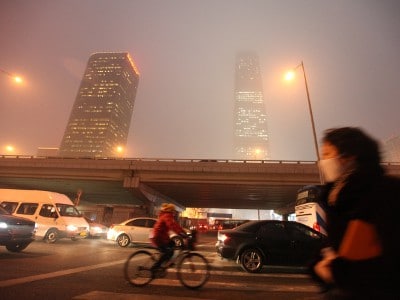China sending mixed environmental signals as air-quality peaks beyond “red alert” level

 On the same day that a “red alert” has been issued for Beijing’s air quality, a team of researchers has presented research at the COP21 conference in Paris suggesting that global CO2 emissions have decreased in 2015, owing mainly to decreased coal use in China.
On the same day that a “red alert” has been issued for Beijing’s air quality, a team of researchers has presented research at the COP21 conference in Paris suggesting that global CO2 emissions have decreased in 2015, owing mainly to decreased coal use in China.
It’s a confusing mix of optics, with China spent talking up its world-class leadership on clean energy last week in Paris, followed immediately by a very public existential clean-air threat to the lives of its citizens that would seem to undermine any claim the government might have to being environmentally friendly.
On Monday night, the Chinese government issued its first ever “red alert” for Beijing’s air quality, issuing orders that half of the city’s cars be ordered off the streets via an odd-even license plate ban, that schools and nurseries close, and that outdoor construction comes to a halt, effective Tuesday morning and forecast to last until at least December 10, with the predicted arrival of a cold front.
While an air-quality alert is typically issued when the city’s air-quality index rises above 300, the government is now saying that the measurement is now above the maximum reading of 500, or what it would call “severely polluted”, resulting in its first ever “red alert”.
As of 6:00 p.m. on Monday, the American embassy’s air pollution monitor in Beijing was recording levels of the microscopically small and poisonous PM2.5 particles at 10 times the recommended limit.
Beijing’s smog, which plagued the capital through November and has now reached a peak, is being blamed on increased power consumption caused by unusually cold temperatures.
Beijing issued an orange alert on November 30, the second highest on its four-tiered system, which was implemented in 2013.
Although China still relies on coal for 60% of its power needs, the government has been making heavy investments in solar, wind and other renewables over the past few years.
To mix messages further, though, on the same day that Beijing’s red alert was issued, another report published in Nature Climate Change and presented at the COP21 conference in Paris has found that “rapid growth in global CO2 emissions from fossil fuels and industry ceased in the past two years, despite continued economic growth.”
The report puts the CO2 stall down to decreased coal use in China, “coupled with slower global growth in petroleum and faster growth in renewables.”
For the first time since the year 2000, from which time there has been average 2-3% annual global increase in CO2 emissions, 2014 saw no growth and 2015 is likely to record a 0.6% emissions shrinkage.
Somewhat encouragingly, while CO2 emissions stalled, global economic growth continued at 3% in both 2014 and 2015.
The stall in emissions is being credited to factors like the fact that China is now home to the largest solar array in the world, the Huanghe solar farm on the Qinghai plateau, with some four million solar panels.
But for many, China’s embrace of renewable energy technology is too little, too late.
China was responsible for 27% of global emissions in 2014.
Researchers at the University of California, Berkeley published a paper in August asserting that 1.6 million Chinese people die each year as a direct result of heart, lung and stroke problems caused by air pollution.
That’s about 4,000 people per day, accounting for one in six total premature deaths.
President Xi Jinping was in Paris last week, singing the praises of his country’s about-face on fossil fuels and its embrace of renewables.
The issuance of the red alert is, to say the least, a loss of face for the Chinese leader among other COP21 delegates.
But perhaps it’s this combination of air-quality emergency, threatening not just the health but the lives of Beijing residents, and momentum and/or embarrassment generated out of the conference that may actually motivate China to double down even further on its drive to decrease coal consumption and increase the profile of renewables in its energy mix.
#Beijing issues first red alert for heavy #smog. Odd-even car ban imposed; schools suspended pic.twitter.com/F3ZNU0Mvyg
— China Xinhua News (@XHNews) December 7, 2015

Terry Dawes
Writer
